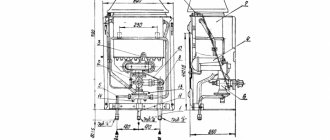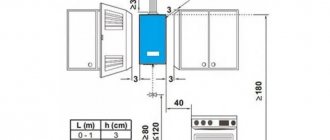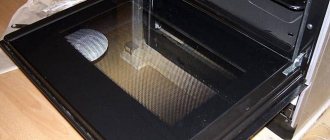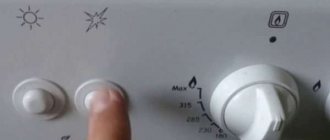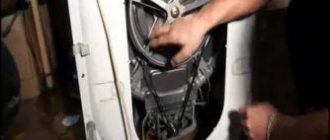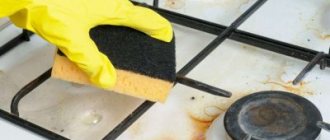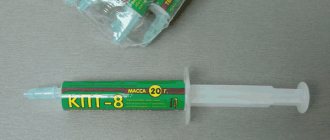How to change the membrane in a gas water heater: choose and install it yourself
The efficient operation of the water heater depends on the serviceability of all components and mechanisms. The membrane in the geyser is one of the important parts, but it wears out over time. How to do the replacement yourself? For this we have a detailed work plan.
Membrane functions, causes of malfunction
An elastic membrane is located at the base of the water unit and reacts to pressure changes in the system. As soon as you open the faucet, the rubber element bends under pressure and pushes out the stem. The rod in turn actuates the gas valve. This is how the fuel enters the burner.
With intensive use of the “Vector”, “Neva”, “Oasis” columns, the membrane wears out. Rubber stretches, becomes clogged and damaged. As a result, fuel does not enter the burner: the column does not ignite or ignites, but immediately goes out.
Signs of breakdown
How do you know when it's time to change the rubber diaphragm? You need to pay attention to:
- The pressure force of gas and water in the system. Open the tap and count how many liters are consumed per minute. Normally there should be at least two to three liters. The gas supply can be calculated visually by looking at the strength of the fire.
- Flame location. In devices with wick ignition, the fire should burn from the edge of the burner and be at least 3-5 centimeters high. Does not match? Then check the jets for blockages. After cleaning, look at the flame again. If the situation does not change, the problem is in the diaphragm.
- Equipment with piezo ignition should click when the button is pressed. This means that the diaphragm has worked. If you do not hear any sounds, the part may be damaged or torn.
- In some models, a rod that controls the operation of the control unit will help determine the breakdown. Remove the protective cover and open the water. If the rod does not move, the diaphragm needs to be replaced.
Once you have found the breakdown, you need to select the correct replacement part.
How to choose a new part
For each column (Termet, Ariston, Beretta), the membrane is selected individually. For foreign models, it is most difficult to find a replacement, since the product can only be purchased from an official supplier. In this case, you have a choice: spend money on a new element or buy a new speaker.
With domestic technology everything is simpler. Replacements can be found in stores or ordered online.
Experts recommend choosing a silicone diaphragm. It is more elastic and durable.
If you think that the principle of construction of all membranes is the same, this is not so. For example, in Ariston water heaters special elements are installed - “eights”. They are made of dense rubber and have a special shape. Their cost ranges from 300 to 500 rubles.
The membrane in Electrolux devices works according to the figure-eight principle. But its price is much lower - from 200 rubles.
The easiest membrane to operate and replace is “Neva” and “Astra”.
There are also universal options, but they are only suitable for temporary installation. It is impossible to fine-tune equipment without factory parts.
DIY repair
For repairs, you will need to disassemble the entire water-gas unit. You will need:
- slotted and Phillips screwdriver;
- wrenches 19 and 24;
- repair kit;
- new part.
First of all, turn off the water and gas supplies. After this, open the tap in the bathroom and drain the remaining water.
- Remove the regulators from the housing by pulling them towards you.
- If you have a display, disconnect the wiring leading to it.
- Now you need to remove the casing. In some models it is fastened with bolts at the top and bottom, in others it “sits” on latches. Pull the facing towards you and up.
A water node will open in front of you. In earlier models it is located separately, vertically. A gas block is installed on top, a water supply is organized on the left, and a heat exchanger on the right.
To dismantle such an element:
- Unscrew the two nuts on the water pipes. Use the key for 24.
- Unscrew the two mounting screws, pull down and remove.
In the latest models, the water unit is placed horizontally. There is a special tap at the bottom through which the remaining water is drained.
- Unscrew the fastening nuts with a 19mm wrench.
- Disconnect the supply sensors.
- Remove the bolts that secure the block to the base.
- Remove the burner.
- Unscrew the fasteners of the water-gas unit with the manifold.
You can start disassembling. In the old Astra and Neva variations, you need to unscrew eight bolts to separate the assembly. In modern models “Neva” 4513, 4511, 4510, “Oasis”, “Vector” only four screws hold it.
If the fasteners are rusty and stuck, spray them with WD-40.
All that remains is to remove the worn membrane and install a new one.
Reassemble in reverse order. Upon completion of work, carry out an inspection. Gradually opening the water supply, inspect all connections for leaks. Then open the tap fully. Everything is fine? Put on the casing, supply fuel - enjoy hot water to your heart's content.
In the video they change the aperture for some models:
The gas heater does not light up
Most often, the cause of such a breakdown is a lack of draft in the ventilation. This occurs due to a foreign object entering the shaft or becoming clogged with soot. You can simply verify that there is no draft: if the flame of a lit match deviates to the side, there is draft; if the flame does not sway, there is no draft.
There are other reasons why a gas heater does not light up. For example, if the elements of the device responsible for generating a spark in automatic ignition systems are not charged, this can also render the installation inoperative.
Another reason for the dispenser to malfunction may be insufficient pressure in the water supply system. If the cold water pressure has become worse, then most likely the fault lies in the water supply system. If the cold water pressure is good, but the hot water barely flows, then the water unit of the installation may need to be repaired (membrane repair or filter cleaning).
The filter becomes clogged due to a water supply shutdown. It is necessary to remove it and rinse under pressure of water. Removing the membrane is more difficult, but the geyser diagram will help with this. If the surface of the membrane is deformed, it must be replaced. To do this, you can choose a silicone product that has a longer service life. Stores that sell spare parts for geysers can offer such options.
There are situations when the unit goes out immediately after ignition. The reason for this is poor-quality contact between the thermocouple and the solenoid valve. If the thermocouple is in good condition, the gas flow column is suitable for repair (cleaning contacts and the automation unit).
How to replace a geyser membrane: reasons + instructions for repairs
Domestic water heaters - gas water heaters are used in old high-rise buildings and private houses to prepare sanitary water. Their parts and components tend to wear out just like any other equipment. Most often, the membrane of the water reducer fails, which you can change yourself.
We will tell you how to replace the membrane of a geyser. The article we have proposed describes in detail the steps to prepare for replacing the membrane and provides recommendations for its selection. Taking into account our advice, you will be able to monitor the operation of the gas heater or restore the functionality of the water heater yourself.
About the reducer and the location of the membrane
A device called a water reducer is part of almost any design of gas heat exchangers.
This part may have different configurations depending on the model of the water heating apparatus, but the principle of operation of such devices remains unchanged.
A water reducer installed on a gas water heater serves to stablely maintain water pressure directly in the water heater heat exchanger system. Due to the uniformity of pressure, a uniform flow is ensured, which means the same uniform heating of the liquid.
A part of the gearbox that facilitates smooth pressure regulation is a rubber membrane. This gear component, made in the form of a gasket, usually based on technical rubber, has the shape of a circle. It is installed inside the gearbox housing.
Due to the long-term operation of water heating equipment, being constantly in motion, the membrane gradually wears out. Wear of technical rubber in some places leads to tears in the material. Accordingly, the function of regulating water pressure stops operating according to the specified algorithm.
In such cases, it becomes inevitable to replace the rubber membrane of the reducer in the gas water heater, because the water heater does not work properly.
The quality of sanitary water heating decreases sharply, and in other cases the column simply cannot be put into operation. Comfort for the user is lost.
Reducer Diaphragm Replacement Steps
If we proceed from the rules for servicing gas equipment and strictly follow these rules, performing any installation, plumbing work, as well as work related to power supply is the prerogative of gas service providers, in particular, the local gas service company.
What do you need to know before starting work?
In other words, owners of gas water heaters are prohibited from carrying out work on gas equipment themselves. And even taking into account that the water reducer is theoretically not related to the gas system, disassembling this structural part and changing the membrane with your own hands is also prohibited.
Sometimes the desire to do everything yourself, without having practical experience in performing this kind of work, can result in disastrous consequences. As evidenced by the numerous accidents associated with household gas equipment.
However, premature wear of the membrane and other components of the water heater under pressure can be prevented by promptly cleaning the equipment with your own hands or by a gas service representative.
There are often craftsmen who are ready to independently change the gearbox membrane on a gas water heater. Moreover, it is, in fact, not at all difficult to perform such an operation if you have plumbing skills.
Do this easy job as follows:
- Using documentation or by opening the column housing and examining the internal contents, determine the brand (model) of the installed gearbox.
- Based on the technical information obtained, they purchase a new membrane on the market.
- If the equipment is imported, you may have to purchase the membrane only to order.
- If there is a membrane, shut off the gas supply to the equipment and close the cold water supply tap from the central heating system.
- Drain the contents of the gas heater heat exchanger using the service drain valve, the location of which is determined according to the documentation.
After these operations, you can begin dismantling the gearbox. However, there is no need to rush here. You need to work carefully and carefully so as not to damage other nearby parts of the gas water heater.
Gearbox removal and disassembly
The water pressure reducer has inlet and outlet pipes. Actually, thanks to threaded union connections, the device is mounted inside the gas system, directly on the water flow line.
Therefore, in order to dismantle the device, it is necessary to unscrew the two union brass nuts securing it to the pipeline. But before doing this work, it is recommended to unscrew one or both plugs on the gearbox drain outlets, which are located under the disc housing.
The nuts should be unscrewed smoothly, while simultaneously holding the device from possible rotation. The mechanism of the device has a regulator rod that is in contact with another part of the gas water heater. On some models, the rod head is secured with a screw. This point should be taken into account and, if necessary, loosen this screw.
Dismantling may be accompanied by residual water leakage. It is recommended to stock up on convenient, capacious containers for collection.
Brief instructions on replacing the membrane
The removed pressure regulator will need to be disassembled to get to the rubber (silicone) membrane. The disassembled part looks roughly like a plate.
- Unscrew the fastening screws on the top of the plate;
- carefully use a flat-head screwdriver to bifurcate the plate;
- remove the defective membrane;
- install a new one;
- articulate the halves of the plate;
- secure the joint with screws in a circle.
The correct location of the membrane on the gear plate is determined by a special “key” recess or pin, which, in turn, is located on the radial edge in the same row as the holes for the mounting bolts.
You need to align the membrane “key” with this notch before connecting the plate halves and screwing in the screws.
The moment of screwing in the mounting screws is a traditional action. However, you should keep in mind the uniformity of tightening of the gearbox parts. Technically competent tightening is performed using the “crosswise” method. That is, first, four screws located one opposite the other are tightened sequentially, and only then all the others are tightened.
The assembled gearbox, equipped with a new membrane, is installed in place in the reverse order. Carefully insert the rod inside the tube of the control device, align the device to the level of the water pipes. The nuts are then manually screwed onto adjacent sections of the pipe.
As a rule, pipe connections require the presence of sealing gaskets and their correct installation. This point must be taken into account when installing the gearbox at the installation site. Next, all that remains is to tighten the fastening nuts, applying a little force and do not forget to tighten the drain plugs under the plate.
Membrane shapes and materials
The design of geysers is varied. Accordingly, a change in the design of the pressure reducer cannot be ruled out. Therefore, the existence of reducing membranes of various shapes also seems to be an obvious phenomenon.
If a round-shaped product, which can often be found when disassembling the valves of domestic geysers, is considered standard, imported devices are often equipped with “exotic” ones.
One such example is the geysers of a well-known foreign company that produces household appliances under the Electrolux brand. Many models of equipment from this brand are equipped with figured membranes in the form of a “figure eight”.
The devices of the foreign company Vaillant are somewhat less popular compared to Electrolux, but they also stand out from the entire range of household geysers due to the non-standard production of gear membranes. When disassembling their valve, there is a chance of colliding with the flag membrane.
For the sake of objectivity, it should be noted: products of non-standard shape show finer regulation of flow pressure, however, in terms of long-term performance, they are often inferior to standard ones. Often the degree of durability is determined by the quality of the material.
In practice, it has been noted that silicone membranes last longer than rubber ones. However, for silicone, an important criterion is careful filtration of network water. Even a small amount of sand or rust that gets into the area where a silicone product is located will dramatically reduce the service life of the material.
Technical rubber is less sensitive to the effects of suspended particles, but for the most part “suffers” from insufficient chemical resistance. That is, if the composition of the water has an aggressive component to some extent, under these conditions, products made from technical rubber usually do not last long.
Repair of geyser membranes
The desire to save on everything forces some users to resort to such a virtual replacement technique as repairing a defective membrane with their own hands.
It should be noted right away: this activity may be interesting for a home handyman, but, from a service point of view, it is absolutely irrational and pointless.
They try to repair geyser membranes in different ways:
- by puttingty with silicone sealant;
- using various types of adhesives;
- application of pentelast;
- installation of miniature patches;
- and even masking tape.
The activity of such a “repaired” part lasts, as a rule, no more than 1-2 days. After which the problems begin again, and often worsen.
Repairing membrane plates of geysers, especially with your own hands, ends in failure in any case. Tested in practice more than once. So, it is not recommended to change the “awl for soap”, unless there is a purely research interest in this matter.
If it is not possible to restore the functionality of the wall-mounted water heater, you will have to buy a new gas water heater. The following article, which examines this current topic in detail, will introduce you to guidelines for choosing equipment.
Conclusions and useful video on the topic
The video demonstrates the personal experience of one of the heater owners - that is, do-it-yourself repair of the water pressure regulator. In particular, all repairs come down to replacing the membrane. We remind viewers once again: independent repair of gas systems is unacceptable!
It’s easier to find and buy a new membrane for a geyser, replace this accessory according to the instructions described above and sleep peacefully. Moreover, replacement, in most cases, does not require significant financial costs. On average, 200-300 rubles are enough to purchase a complete accessory.
Please leave comments, post photos related to the topic of the article and ask questions in the block below. Tell us about how you selected and changed the membrane in a gas water heater. Share useful information and technological nuances that will be useful to site visitors.
How to choose a new part
For each column (Termet, Ariston, Beretta), the membrane is selected individually. For foreign models, it is most difficult to find a replacement, since the product can only be purchased from an official supplier. In this case, you have a choice: spend money on a new element or buy a new speaker.
With domestic technology everything is simpler. Replacements can be found in stores or ordered online.
Experts recommend choosing a silicone diaphragm. It is more elastic and durable.
If you think that the principle of construction of all membranes is the same, this is not so. For example, in Ariston water heaters special elements are installed - “eights”. They are made of dense rubber and have a special shape. Their cost ranges from 300 to 500 rubles.
The membrane in Electrolux devices works according to the figure-eight principle. But its price is much lower - from 200 rubles.
The easiest membranes to operate and replace are “Neva” and “Astra”.
There are also universal options, but they are only suitable for temporary installation. It is impossible to fine-tune equipment without factory parts.
How to replace the membrane in a geyser with your own hands
- Content:
- How does a membrane in a column work? What is it responsible for? Types of membranes for columns
- Signs of a membrane failure in the column - how to check
Replacing the membrane in a gas water heater yourself will be easier if you understand how the water regulator works and what purpose it serves. There are general signs that indicate that the rubber diaphragm has failed and the assembly needs to be repaired.
How does a membrane in a column work? What is it responsible for?
The principle of operation of the membrane in a gas column is as follows:
The water regulator is a metal assembly with an empty cavity divided into two parts by a diaphragm.- The first compartment is necessary for filling with water. After opening the hot water tap, liquid flows into the connected part of the regulator. Pressure is created inside the assembly, bending the gasket.
- The membrane in the gas column presses on the rod located in the adjacent section of the regulator. A metal rod opens the gas valve and at the same time gives a signal to electrically ignite the burner (in automatic dispensers).
- After closing the hot water tap, the pressure drops. There is a spring on the metal rod that returns it to its original position. The gas supply is interrupted. The burner goes out.
The design of the membrane on the gas water heater may vary depending on the model of the water heater, but the basic principle of operation remains unchanged. Over time, the diaphragm wears out, becomes insufficiently elastic or breaks, which leads to failure of the heat generator.
Types of membranes for columns
The gas water heater diaphragm is a round gasket made of black rubber or silicone. Depending on the speaker manufacturer, the membrane may contain hard plastic or metal elements. Some diaphragms are reshaped.
Gas water heaters made by European manufacturers use diaphragms that are difficult to counterfeit. For example, the Ariston Fast GIWH has a so-called “figure eight”, while the Electrolux GWH or Vaillant MAG has a diaphragm with a special eye. You can only purchase such a gasket at an official service center. A frog membrane for a European water heater costs from 200-500 rubles. For comparison, a repair kit for the domestic NEVA Lux 5013 (5016), together with plastic parts, costs only 150-200 rubles.
If we talk about the material from which diaphragms are made, there are several types:
- The black rubber membrane is a classic look. Most manufacturers prefer to make gaskets from black rubber. Such a diaphragm will last 7-8 years, provided that there are no defects.
- Silicone membrane - guaranteed to work for 10-12 years. On the market you can find gaskets for domestic and Chinese equipment. Owners of European water heaters will have to make do with black rubber diaphragms.
- Red membranes - low quality material is used. The rubber breaks after turning on the speaker several times. Suitable as a temporary measure. It happens that the necessary gasket has to be ordered directly from the manufacturer. Having installed the red membrane, you can continue to use hot water while awaiting delivery of the original part.
You can fully find out which diaphragm is used in the technical documentation supplied with the instantaneous water heater or after disassembling the water regulator.
Signs of a membrane failure in the column - how to check
- The water regulator is leaking - in normal condition, the gasket completely covers the part of the unit in which water circulates. It only starts to drip if the membrane is torn.
- It takes a long time from opening the hot water tap to turning it on - if the unit is working properly, the burner lights up after 1-2 seconds. There are several reasons for the long response time:
- The membrane is leaking - provided that the leaking small column will work for some time. Over time, water will begin to drip from the regulator.
The membrane has stretched - in this case, the pressure on the rod will not be enough to open the gas supply. The same problem occurs when the gasket becomes rough due to hard water.
- The microswitch rod of the electronic unit does not turn on - another characteristic sign that the diaphragm has become unusable. The column shows no signs of life.
The membrane on the column fails due to poor water quality. The surface becomes rough and loses elasticity. Over time, microcracks form that allow water to pass through.
Is it possible to make a membrane yourself and from what?
Before starting repair work, you should make sure that the poor operation of the burner device is due to a failed diaphragm. The cause of a malfunction of the water heater can be dead batteries and malfunctions in the igniter. Only after all other breakdowns have been ruled out do we proceed to repair the water regulator.
Diaphragm problems often arise unexpectedly. It takes several days for a suitable pad to arrive. To use hot water all this time, you can restore the membrane yourself or make it yourself.
For temporary laying, rubber with a thickness of 1.5-2 mm is suitable. Some people use an old car inner tube or thick household gloves as a blank. The holes for the bolts and the bypass channel are made with a punch, which is easy to make yourself from a metal tube.
A new diaphragm is cut out using the old one as a template. As a temporary measure, you can seal the membrane by applying a patch. After repair work is completed, the column will be able to work for some time, sufficient to purchase a factory diaphragm.
How to properly install a membrane on a gas water heater
The gasket is located inside the water regulator (frog). Replacing the diaphragm is not difficult. Before starting work, turn off the gas and water supplies. The liquid is drained. To do this, open the DHW tap located below the lower level of the column. Repair work is carried out in the following sequence:
- Remove the speaker casing - in most modern devices the casing simply hangs on hooks. To remove the cover, simply lift it up.
- Dismantle the water regulator - to do this, disconnect the cold water supply and unscrew the gas reducer.
To change the diaphragm on a gas water heater, the “frog” is disassembled. Typically, you will need to remove a few brass bolts. They should be unscrewed carefully so as not to damage the folds. This will give you access to the gasket. After replacing the diaphragm, the water regulator is reassembled in the reverse order. Turn on the gas and let in the water. Do a test run of the water heater.
If any of the above is difficult, it is better to call the gas service experts. Replacing the membrane will cost 900 rubles, plus the cost of the material.
Most geysers, from the ancient KGI-56 to modern imported ones with a bunch of smart electronics, contain a rubber membrane that separates the cavities of the water regulator. And sooner or later this membrane breaks. Is it possible to replace the membrane in a geyser with your own hands? Well, nothing is impossible!
Damage to the membrane in a geyser is a fairly common and simple malfunction, so a skilled person can easily handle it with his own hands.
Please note that according to the operating instructions, geyser repairs must be carried out by qualified personnel. Attempts at self-repair without the necessary knowledge and experience in servicing gas equipment can lead to equipment damage and gas leakage. Don't overestimate your strength. If you have the slightest doubt, contact gas service specialists.
How to determine a membrane failure?
Damage to the membrane is one of the most easily diagnosed geyser failures. First, make sure that the water and gas pressure is sufficient for normal operation of the column. The flow rate through the hot water tap should be at least 2-3 liters per minute. Gas pressure can be assessed by eye, by the shape of the flame in the burners on a gas stove.
For wick fired dispensers, check the size and position of the pilot flame. The flame should be 3-5 cm long and positioned exactly above the edge of the main burner. If this is not the case, then it is necessary to clean the pilot burner nozzle. If even after this the column does not light up, then most likely the problem is in the membrane.
For speakers with battery ignition, it is necessary to monitor ignition attempts. If the column tries to turn on (clicks are heard), then the membrane is in order; the reason must be sought in the ignition electrode or gas part. If there are no clicks, there may be several reasons, but membrane rupture is the most likely cause and can be easily verified by disassembling the unit.
In some speaker models, the serviceability of the membrane is checked by moving the rod that controls the microswitch of the electronic unit. This is clearly visible when the column casing is removed. If the rod does not move when you open a hot water tap, then the problem is definitely in the membrane.
Membrane rupture may occur suddenly or may develop gradually. In this case, a small crack first forms, through which water flows between the cavities of the water regulator. The pressure drop drops and the column cannot turn on at full power. Gradually everything gets worse and worse and, finally, the column does not turn on at all.
How to choose a membrane for a geyser?
The next step is to select a replacement membrane. For some models of geysers, especially for imported manufacturers, there is not much to choose from. You can purchase the membrane only from the manufacturer’s dealer and often at an inflated price. And sometimes even this is not possible because spare parts are simply not supplied. At this point you will have to change the entire column or come up with a solution using improvised means.
For more common models, membranes can be purchased from local or online stores that sell spare parts for gas equipment. The price of the membrane depends on its design and material used, as well as the prevalence of the geyser model.
Some membranes are quite complex and tricky. Here, for example, is the membrane for the Ariston Fast GIWH geyser, the so-called “figure eight”.
It is produced only in this version, made of black rubber and costs 300-500 rubles, depending on the seller’s appetite.
Membranes for geysers Electrolux GWH or Vaillant MAG are much simpler. These are also products made of black rubber, their cost is 200-250 rubles.
Some types of membranes are suitable for both imported and domestic geysers of recent years of production. Here, for example, is the membrane for the NEVA Lux 5013 (5016) geyser, exactly the same one used in the MORA 5502-5507 columns. The cost of such a membrane is 150-200 rubles.
At a slightly more expensive price (200-250 rubles), such a membrane can be purchased assembled with plastic parts adjacent to it. If the column has worked for more than 5 years, then this is exactly what you should do; plastic parts become brittle over time due to leaching of plasticizers.
There are also rubber-metal membranes, for example, for the NEVA Lux 5513 (5514, 6011, 6013, 6014) geyser. These are more expensive, 200-300 rubles.
But the widest selection is offered for old gas water heaters VPG-18, VPG-20, VPG-23, NEVA 3208 (3210, 3110, 3112), Darina and Neva 4510 (4511, 4513). And this is where it’s worth thinking.
If there is an alternative, then it makes sense to give preference to a silicone profiled membrane .
This material itself is very resistant and elastic, and the shape of the membrane allows it to work not by stretching, but by bending. A silicone membrane costs 50-100 rubles, and can work in more or less clean water for at least 10 years. The photo shows the original membrane from the Neva-3208 gas water heater, produced in 2002. She has been working non-stop for twelve years now and has no intention of giving up.
Thick profiled membranes made of black rubber . They cost about the same as silicone ones, but last a little less - 5-8 years, if there are no defects.
And just out of desperation, you can install a flat white membrane made of vacuum rubber . These were installed in old speakers like KGI-56, and even now, no, no, and they are offered, including for the Neva-3208.
No, such a membrane will work, but for how long? It works by tension and most often lasts no more than a year. There is no point in buying such a membrane for more than 30-50 rubles.
Sometimes membranes made of thin red rubber . Just from the quality of workmanship it is clear that they are produced almost in a handicraft manner; the holes are uneven with burrs and cracks.
You can take a risk and bet, especially if there are no other options, but there are reviews on the Internet about the rupture of such membranes the first time you turn on the column. Again, nothing bad will happen, you’ll just have to disassemble the column again and install another membrane.
Sometimes it happens that it is not possible to purchase the right membrane right away, because delivery from online stores takes at least several days. In this case, if the membrane is not too complex, a temporary membrane from a more or less suitable material. Rubber 1.5-2 mm thick from a car inner tube or thick household gloves is suitable. Please note that the material must stretch, so rubberized fabric will not work.
The membrane is simply cut out with scissors, using the old one as a template. It is better to make holes with a punch made of a thin-walled metal tube. Pay special attention to the hole in the bypass channel . It can be distinguished by its increased diameter and “illogical” location in the space between the mounting holes.
This hole must be clean and of the required diameter so that when assembling the water regulator it does not block the bypass channel.
By the way, if you have to purchase a membrane through an online store, do not rush. Spend half an hour or an hour searching and you will be surprised how much you can save. For example, there are online stores offering a simple rubber membrane for the Neva-3208 column for 550-650 rubles. If you search a little, you can buy the entire water regulator for Neva-3208 assembled for almost the same price!
How to replace the membrane?
The process of replacing the membrane in a gas water heater is most often simple. First of all, you need to turn off the column and shut off the supply of cold water and gas. It is also necessary to open one of the hot water taps to relieve pressure in the pipes.
a little trick here - you need to open the tap that is located below the column, usually a mixer in the bathroom. Then, during disassembly, all the water in the heat exchanger and pipes will drain through the open tap due to the siphon effect. If you open the tap in the kitchen and it is higher than the location of the water regulator, then 3-5 liters of water will pour out onto your feet.
Now you need to remove the casing of the gas water heater. The mounting points for the casing are different for each model, but most often they are not difficult to find. Sometimes the mounting screws are located under decorative trims or speaker control knobs.
In some cases, there is no fastening at all, and the lid simply hangs on hooks. After removing the casing, access to the internal structure of the column opens. You can start replacing the membrane.
In older speaker models, the membrane is located in the water regulator, which is made as a separate part. Finding a water regulator is very simple - this is the first thing that includes a pipe that supplies cold water to the column.
To remove the water regulator, simply unscrew the two union nuts securing the water pipes and the three screws securing the water regulator in the gas part. After this, the water regulator is simply pulled down.
In more modern geysers, which provide automatic adjustment of hot water temperature and ignition from batteries, the design is rotated 90 degrees. But to remove the water regulator, you also need to unscrew the union nuts on the pipes and the fixing screws.
Also common are geysers in which the gas and water parts are combined into a single unit. This, for example, was done in the MORA 5506 column and the similar NEVA Lux 5013.
The water regulator cover is located on the right; to remove it, you need to unscrew two union nuts and four T20 head screws (internal sprocket). With some persistence, you can unscrew such screws with a regular flat-head screwdriver of a suitable size, but traces of tampering will remain.
The cover in the photo is shown after cleaning with a solution of phosphoric acid in an ultrasonic bath; usually brass looks much worse after several years of use. However, appearance does not affect performance. (Photos of the MORA 5506 column are taken from a post by user Wladimir_TS on the forum of monitor.net.ru).
Now all that remains is to disassemble the water regulator and replace the membrane with a new one. Pay special attention to correct assembly - it is important not to place the membrane upside down and not to block the bypass channel connecting the halves of the water unit.
The gas water heater is assembled in the reverse order; do not forget to replace all the gaskets. With some experience, replacing the membrane takes no more than 15 minutes.
Do you know that…
... there are geysers in which there is no membrane at all, for example Nobel FOSS 1. The flow sensor in this case is an impeller similar to the one located in a water meter. It is strongly recommended to install a main water filter with a mesh size of no more than 100 microns in front of such columns, otherwise the sensor will not last long. The same applies to dispensers ignited by a hydrogenerator.
We recommend reading
- What is an RCD?
- How to make a simple hidden wiring finder?
- How to control lighting from several places?
- How to clean silver at home?
- How to find a good electrician?
- Typical mistakes of unprofessional electricians. Part 1
- Installation of a steel bath. How to do it right?
- Which bathtub is better to buy?
- How to connect wires correctly? Electrical wiring in the apartment
- Ten commandments of a good electrician
How to replace the membrane in a gas water heater yourself
Most water heaters, from the oldest to new generation devices with built-in smart equipment, have a special membrane for the gas water heater. It is necessary to separate the internal space of the fluid regulator. This part is classified as consumable and wears out over time. In this regard, owners of geysers often have the question of how to replace the membrane, and do they need to call a specialist for this?
What you need to know
Over time, even the most reliable membrane becomes unusable - this is one of the most common problems for geysers. It is quite possible to replace a worn-out element with your own hands. If you strictly follow the instructions in the instructions, even an ordinary person can easily cope with this.
However, it should be remembered that repairing gas equipment involves a certain risk. Mistakes may not only result in equipment failure, but can also lead to injury, gas leaks, or fire.
Part wear usually occurs over time as a result of intense use, but it can also happen suddenly. Be that as it may, a microcrack appears in the barrier, through which water begins to leak from the adjacent cavity of the water regulator. The flow of water causes a drop in pressure levels, and the column cannot function normally. Over time, the gap increases, further reducing the pressure. As a result, the system shuts down completely.
Membrane for geyser Beretta Aqua
How to determine membrane failure
The reason that the geyser does not work correctly is most often a torn membrane. First of all, check the water and gas pressure levels. Normal operation of a household appliance is impossible if it is unstable or does not reach the standard. Count the amount of hot water consumed through the tap. Its volume should be between two and three liters per minute. The level of gas pressure can be estimated by eye, focusing on the shape of the fire in the burners of the gas stove. There are different methods for different types of speakers.
Wick ignition
When dealing with devices of this type, pay attention to the location of the pilot light and its size. Ideally, the tongue should reach three to five centimeters in height and be located directly under the edge of the main burner.
If the signs do not match, this may indicate a problem, for example, a clogged jet. Try cleaning it and inspecting it again. If the procedure does not help and the column stops lighting up, then the problem is definitely in the membrane.
Battery ignition
If the column is ignited with a button, you should periodically monitor for attempts at ignition. When turned on, the owner should hear a certain sound, similar to a click. This means that the rubber membrane is working properly, and the source of the problem must be sought in the gas part or the ignition electrode. If clicks were not heard, there is a high probability of membrane rupture. However, this phenomenon is caused by several reasons; you can find out what’s wrong only by disassembling the assembly.
Other cases
There are models of water heaters in which the performance of the membrane is determined by the movement of the rod, which regulates the operation of the electronic unit using a microswitch. The easiest way to notice this is to remove the protective casing. A static part when the hot water supply tap is open becomes clear evidence of a failed membrane. In this case, replacement of the rod is not required.
How to choose a replacement membrane
Having identified the cause of the problem, you can begin to select a replacement part. At this stage, the owner may encounter difficulties, because for some models, especially those produced abroad, there are simply no spare parts. Purchasing a membrane becomes a real problem: you can only get it from an official dealer of the manufacturer, which significantly inflates the cost. There are two ways out of this situation: purchase a new speaker or try to pick up a part from another model.
With more popular geysers such problems will not arise. Spare parts for them can be purchased in specialized stores or ordered online. Even a technician called to your home can install them for you for an additional fee. The cost of the membrane will increase depending on its type and the material used in its manufacture. The brand of a household appliance can also affect the price, because servicing advertised speakers is more expensive.
Types of membranes
There are membranes of a special shape, the principle of operation of which is different from the standard scheme. A striking example of such a part can be the consumables for the Ariston Fast GIWH water heater. It is called "eight".
It is cast in a special mold using dense black rubber. The average market price can range from three hundred to five hundred rubles, depending on the place of purchase.
The partition of a household appliance from Electrolux or Vaillant is much simpler. Created on the same principle as the “eight”, it costs only two hundred to two hundred and fifty rubles.
There is an even simpler type, for example, a membrane for a geyser from the company Neva or Astra. Despite its external unpretentiousness, the part copes with its functions perfectly. An additional advantage of this form is the ease of replacement.
There is a type of membrane suitable for all models of geysers - a kind of universal spare part. However, you need to remember that it can be used as a temporary replacement, because it is very difficult to achieve precise equipment settings without factory parts.
Replacing a failed part
The procedure for replacing a used membrane is not difficult.
First of all, you should turn off the household appliance and block access to cold water and gas. In addition, do not forget to reduce the pressure in the pipeline. To do this, open one of the hot water taps and wait a while. The pressure release procedure has its own nuances. It is best to open the tap located at the bottom of the column, usually a faucet located in the bathroom. This will allow the water accumulated in the heat exchanger and pipes to drain freely due to the siphon effect. Of course, you can open the kitchen faucet, but it may be fixed at a higher level than the liquid regulator. In this case, you need to be prepared for the fact that when disassembling the column, some of the water, namely three to five liters, will spill onto the floor. Prepare a suitable container in advance and be vigilant.
Mounting screws for removing the protective cover
Having finished with the pressure, you can begin to dismantle the protective casing of the water heater. The mounting bolts, depending on the model, may be located in different places, but usually they are not difficult to find. In some cases, they may be hidden by decorative elements or panels, as well as under device control toggle switches. New generation units can do without mounting bolts altogether - their casing is held in place by special hooks and can be removed with a little pressure. By removing the barrier, you will gain access to the interior of the device and will be able to replace the partition without interference.
Old speakers
The gas water heater of the previous generation has a special structure. Its membrane is located in the fluid regulator, which is installed as a separate element. It is quite easy to distinguish it from other parts - this is the first element that is connected to the pipe through which cold water is supplied to the column.
Column fluid regulator
To remove the water regulator you need to:
- unscrew several nuts securing the water pipes;
- then unscrew the three screws that perform the function of fixing the regulator in the gas section;
- Carefully remove the regulator from the groove by pulling it down.
New generation household devices
Progress does not stand still, and new types of devices are becoming more and more complex every year. Manufacturers integrate automatic ignition and water heating control systems, batteries and touch screens into them. However, to remove the water filter, you will have to follow the procedure described above.
To work with the device, you will need to remove the cover from it. This can be done by unscrewing several nuts and screws with an internal sprocket. By choosing the right screwdriver, you'll get the job done in no time. Having eliminated the obstruction, disassemble the fluid regulator and replace the worn partition with a new one. Carefully monitor the installation of the part, do not place it in the wrong position. After this, reassemble the column in reverse order. This is how the membrane in a conventional gas water heater is replaced.
Sources: https://sovet-ingenera.com/otoplenie/vodonagrevatel/kak-zamenit-membranu-gazovoj-kolonki.html https://avtonomnoeteplo.ru/vodonagrevateli/727-zamena-membrany-gazovoy-kolonki.html https: //tehnika.expert/klimaticheskaya/gazovaya-kolonka/zamena-membrany-v-gazovoj.html
What are membranes for geysers?
A person's life should be comfortable. To achieve convenience, many people equip their homes with various modern devices. Some of them are necessary to have in every home, since without them the standard of living is significantly reduced.
The membrane for a geyser is a round rubber or silicone gasket
With the right choice of column and its use, you can be sure of its long service life. But it also happens that the column breaks. In such situations, owners often do not know where to start repairing. If the outlet water is not at sufficient temperature, the problem is definitely in the membrane, which may have become unusable.
What is a membrane:
- In most speakers, the membrane is made of rubber.
- The membrane for a geyser quite often becomes unusable, the material wears out, which leads to its rupture.
- The membrane is installed in the water unit of the device. It regulates water pressure.
- If the column is turned on, the membrane bends.
- Gas is supplied to the burner, starting the water heating process.
If the membrane is damaged, the column stops heating water efficiently, since cold water does not enter the heat exchanger. After a membrane breaks, many owners wonder how to find a new membrane, what quality it should be, and how to choose a membrane for a specific speaker model. It should be noted that in most cases the speaker design is similar.
Assembling the device
In old Neva and Astra water heaters, we replace the top cover of the water regulator and tighten the eight screws according to the principle of one opposite the other. We determine where the entrance to the regulator is and place it next to the pipe through which water enters the column. The water unit is inserted into the gas unit and three screws are tightened, with which they are attached to each other. It is advisable to change the gaskets at the inlet and outlet. After this, tighten the union nuts with a 24mm wrench.
In new water heaters, we tighten four screws on the water regulator and screw the water-gas unit to the burner. Next, we screw the burner block to the rear wall, connect the ignition and ionization electrodes, and tighten the union nuts with a wrench.
After assembly we check. With the hot water tap open, gradually turn on the water at the inlet of the column. We make sure that there are no leaks anywhere. You can double-check by running dry wipes on the union nuts. After a few minutes, close the tap and check the same connections, but under pressure. If everything is in order, the gas valve opens and the operation of the column is checked. It is important to check the gas connections by applying a soap solution. If there are no leaks anywhere and everything works, you can attach the column casing.
Also, see the video for replacing the membrane of the Astra VPG-21 1-B11-UHL 4.2 column:
Is it possible to make a membrane yourself and from what?
Before starting repair work, you should make sure that the poor operation of the burner device is due to a failed diaphragm. The cause of a malfunction of the water heater can be dead batteries and malfunctions in the igniter. Only after all other breakdowns have been ruled out do we proceed to repair the water regulator.
For temporary laying, rubber with a thickness of 1.5-2 mm is suitable. Some people use an old car inner tube or thick household gloves as a blank. The holes for the bolts and the bypass channel are made with a punch, which is easy to make yourself from a metal tube.
A new diaphragm is cut out using the old one as a template. As a temporary measure, you can seal the membrane by applying a patch. After repair work is completed, the column will be able to work for some time, sufficient to purchase a factory diaphragm.
How to solder a geyser heat exchanger
Preparation for soldering
First of all, you need to remove the casing from the column. This must be done carefully, first disconnecting the wires from the display. In some models of water heaters, for example Neva 4510, the gas and pressure regulators must be removed before doing this.
Next, turn on the water and locate the leak. Often it is located on the bend of the heat exchanger pipes near the sheathing. If it is easily accessible, it will be possible to seal the fistula without removing the column.
If there is no direct access, and the fistula is located from inside the radiator, you will need to disassemble the column and remove the heat exchanger.
Modern dispensers have a special plug for draining water, after opening which the liquid is poured into a substitute container. Remaining moisture is blown out with a compressor or vacuum cleaner.
This is important because during soldering the liquid will boil and evaporate, creating pressure and blowing the solder through the fistula. The last stage of preparation is cleaning and degreasing the leak area. This is done using fine-grained sandpaper.
You need to clean it carefully so as not to make a through hole, since the pipes in the heat exchanger can be very thin. After this, the cleaned tube is wiped with any solvent or white spirit to remove any remaining dirt and grease.
This is done using fine-grained sandpaper. You need to clean it carefully so as not to make a through hole, since the pipes in the heat exchanger can be very thin. After this, the cleaned tube is wiped with any solvent or white spirit to remove any remaining dirt and grease.
The last stage of preparation is cleaning and degreasing the leak area. This is done using fine-grained sandpaper. You need to clean it carefully so as not to make a through hole, since the pipes in the heat exchanger can be very thin. After this, the cleaned tube is wiped with any solvent or white spirit to remove any remaining dirt and grease.
Soldering methods
There are three ways to solder the geyser heat exchanger:
Powerful soldering iron
To solder the fistula site with your own hands, you will need a soldering iron with a power of about 110 W, flux and solder.
The first stage of soldering is applying flux. This is a substance that cleans the surface of the material from oxides and allows the solder to spread more evenly. Flux paste containing copper is best. If it is not available, you can use regular rosin or an aspirin tablet.
Burner with gas cylinder
You will need a burner, a small gas cylinder, flux, and solder. The burner is connected to the cylinder and ignited. You need to choose a not very strong flame so as not to damage the column radiator.
First, the leak site warms up well. This is done to ensure that any remaining moisture in the pipes evaporates. After this, the pipe is heated and solder is supplied to it.
After soldering, it is imperative to remove any remaining flux, because it contains acid and can subsequently corrode the walls of the heat exchanger pipes.
Cold welding
It is important to choose a cold weld that will not melt from hot water. All actions must be carried out wearing protective gloves. A small amount of cold welding comes out of the package
You need to knead it in your hands for about three minutes. As soon as the material begins to harden, you need to apply it to the site of the fistula and hold it tightly until it hardens completely.
A small amount of cold welding comes out of the package. You need to knead it in your hands for about three minutes. As soon as the material begins to harden, you need to apply it to the site of the fistula and hold it tightly until it hardens completely.
If there are several fistulas nearby on the heat exchanger tube or there is a large hole in the tube, you need to solder a copper patch. You can also make soldering from a piece of copper pipe.
How to check for leaks
After soldering the geysers, you need to check the tightness of all pipes. To do this, they are carefully examined to see even the smallest fistulas - their presence is indicated by small green spots. To avoid re-disassembling the column in the near future, these defects are also cleaned and soldered.
After this, you need to connect water to the gas water heater with a soldered heat exchanger and open the tap.
At the very end, the boiler with a gas water heater is turned on to check its performance when in contact with hot water. In this case, the soldered areas can be wiped with a dry cloth to detect the slightest signs of moisture.
Opening the water regulator
To open the water regulator of old Neva and Astra water heaters, you need to unscrew the eight screws on top with a flat-head screwdriver. If the column has been used for a long time and no maintenance has been carried out, the screws may be rusty. The upper half with the rod is removed and the membrane can be changed.
Stores sell repair kits that include the membrane itself, a plate with a rod, a brass bushing and a set of gaskets. You can also buy the membrane separately. Silicone specimens are the most reliable.
Next, you can remove the old membrane and replace it with a new one. It is important to align the bypass holes on the membrane and the regulator, otherwise the column will not work.
To remove the regulator cover in water heaters Neva 4513, 4511, 4510, Vector, Oasis and Electrolux, unscrew the four screws with a Phillips screwdriver. These speakers have a black rubber membrane. The old membrane is removed and a new one is installed. Its shape will not allow the part to be installed incorrectly, since here the bypass hole is located on the side.
How to choose a replacement membrane
Having identified the cause of the problem, you can begin to select a replacement part. At this stage, the owner may encounter difficulties, because for some models, especially those produced abroad, there are simply no spare parts. Purchasing a membrane becomes a real problem: you can only get it from an official dealer of the manufacturer, which significantly inflates the cost. There are two ways out of this situation: purchase a new speaker or try to pick up a part from another model.
With more popular geysers such problems will not arise. Spare parts for them can be purchased in specialized stores or ordered online. Even a technician called to your home can install them for you for an additional fee. The cost of the membrane will increase depending on its type and the material used in its manufacture. The brand of a household appliance can also affect the price, because servicing advertised speakers is more expensive.
